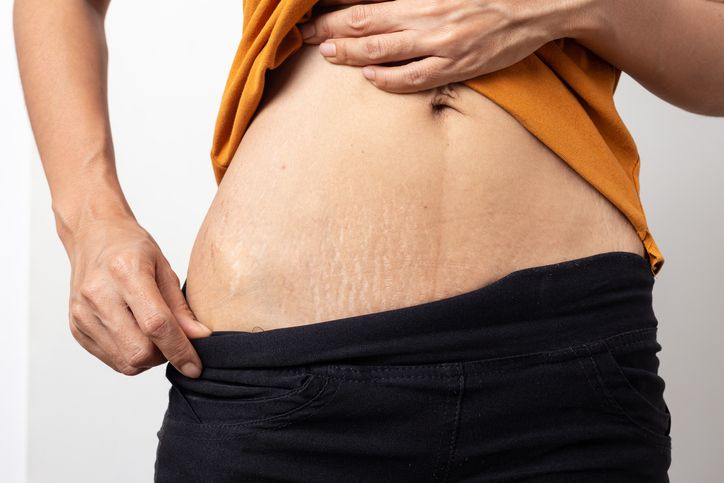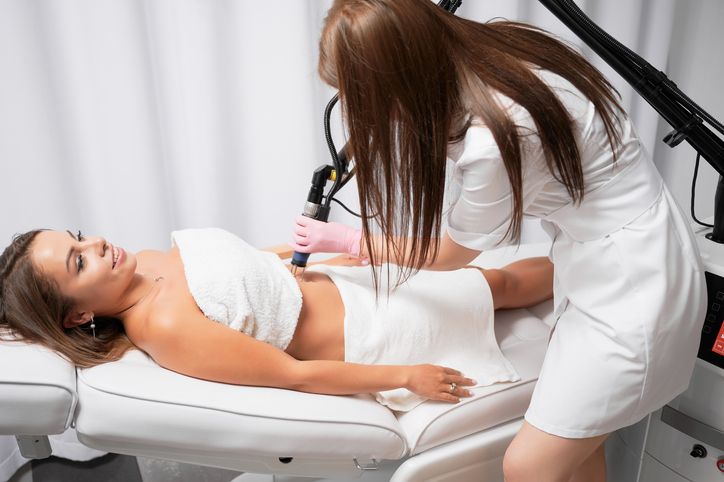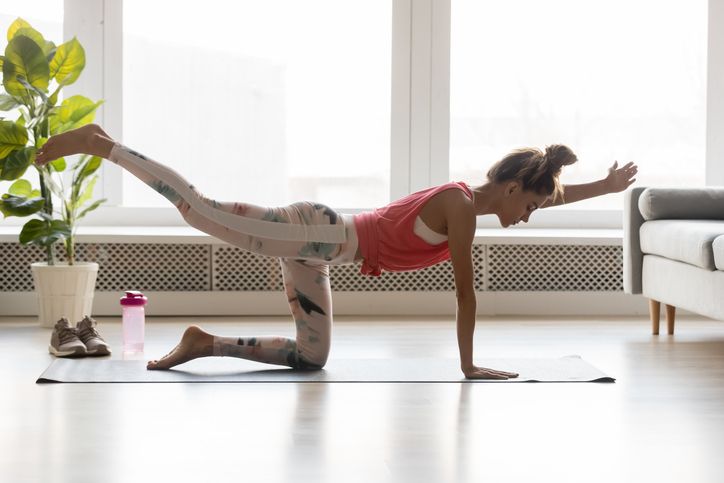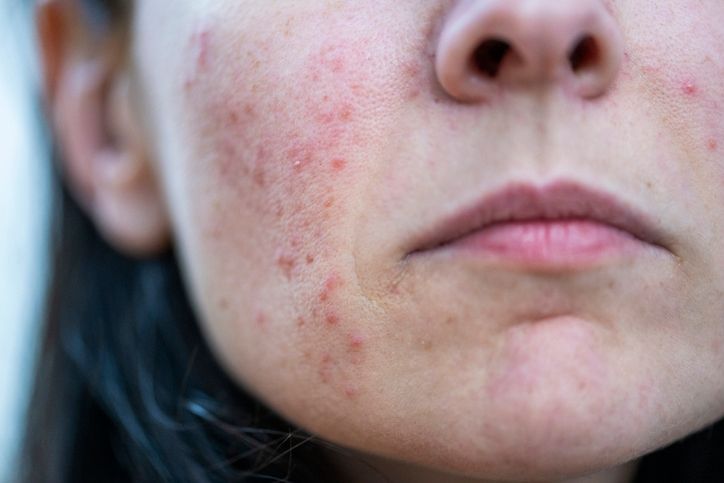
Author: Natalie Ng|Updated: 30 April 2025
Stretch marks can look more noticeable when you lose weight. As your body changes, your skin tightens up — and that can make those little lines stand out more than they did before. It’s totally normal, and it happens to a lot of people. Things like how fast you’re losing weight, your age, your skin type, and even your family history can all play a part. If your skin’s feeling dry or you’ve lost weight quickly, those marks might be more obvious for a while. Stretch marks usually show up when your skin stretches too fast — like during pregnancy, weight gain, growth spurts, or building muscle. They can pop up on your thighs, upper arms, or abdominal area, and they often start out as reddish-brown or purple streaks. They might feel a bit raised at first, but they tend to fade over time — even if they don’t disappear completely. There’s no magic fix to prevent stretch marks, but there are things you can do to help fade early stretch marks and support your skin as it heals. From creams and oils to in-office treatments like laser therapy, you’ve got options. Curious about what actually works? Keep reading — we’ll break it all down.

What Are Stretch Marks?

Stretch marks are common and can show up when your body changes quickly. You’ll usually notice them as narrow streaks on the skin that might be pink, purple, reddish brown, or silvery white, depending on your skin tone and how long the marks have been there.
They often appear on areas like the upper arms, thighs, abdominal area, or hips — anywhere the skin stretches too fast.
Why Stretch Marks Happen
Stretch marks form when the skin stretches or shrinks suddenly. This fast change can tear the deeper layers of the skin, where elastic fibers and collagen sit. When those layers get damaged, stretch marks show up.
This can happen during:
• rapid weight gain
• sudden weight loss
• pregnancy
• growth spurts
• muscle growth
• medical conditions like cushing's syndrome or marfan syndrome
Some people are more likely to develop stretch marks because of their genetics or skin type. Dry skin and reduced skin elasticity also raise the chances.
What They Look Like
New stretch marks — also called early stretch marks — often look reddish brown or purple and may feel slightly raised. Over time, they fade and flatten, but they don’t disappear completely. Older stretch marks can look silvery or white and blend in more with the rest of your skin.
Stretch marks affect both men and women, but they’re especially common in pregnant women. They can also show up from things like rapid growth, hormone changes, or using certain prescription medicine over a long period.
While you can’t fully prevent stretch marks, you can take steps to support your skin as it stretches. There are also ways to fade stretch marks and improve how they look — from stretch mark creams to in office procedures like laser therapy.

Weight Loss And Skin Changes

As your body changes during weight loss, so does your skin. Your skin isn’t just a surface layer — it’s made of multiple skin layers that rely on proteins like collagen and elastin to stretch and return to shape. When you lose weight too quickly, your skin doesn’t always have time to keep up, which can lead to sagging or make existing stretch marks more visible.
Skin Elasticity Basics
Your skin's ability to stretch and bounce back is known as skin elasticity. It depends mostly on two proteins — collagen and elastin — found in the deeper layers of your skin.
• Collagen provides structure and strength. It forms a network in the dermis that helps support the skin.
• Elastin allows the skin to stretch and return to shape. It’s what helps your skin snap back after being pulled or stretched.
• Natural hydration and oils also affect how flexible your skin is. Dry skin can be more prone to tearing when stretched, which increases the chance of developing stretch marks.
When your body expands or shrinks too fast — whether from weight gain, rapid weight loss, or growth spurts — these supportive fibers can become damaged. Once they break, the skin can't fully recover, and that’s when stretch marks may form or become more obvious.
In short, the way your skin responds during weight loss depends on how well these proteins hold up. If your skin’s elasticity is low, you're more likely to notice stretch marks or loose skin during major body changes.
Weight Loss Impact on Skin and Stretch Marks
As you lose weight, your body changes in more ways than just size. Your skin has to adapt too, and this can affect how stretch marks appear.
When weight drops quickly, your skin doesn’t always have enough time to shrink back. This can make stretch marks more visible — especially if they were already there from earlier periods of weight gain or stretch. The faster the weight loss, the harder it is for your skin to adjust.
1. Collagen Production Changes During Weight Loss
Collagen is one of the key building blocks that keeps your skin firm and structured. When you lose weight, especially if it’s fast, your skin goes through a lot — and collagen production doesn’t always keep up with those changes.
• As you lose weight, your skin is under mechanical stress, especially in areas like the thighs, arms, and abdomen. That stress can affect how well collagen fibers stay organized, making the skin less firm.
• If you’re older, your fibroblasts (the skin cells responsible for producing collagen) slow down naturally, which makes it harder for your skin to keep its structure during big changes.
• Rapid weight loss can throw off the balance between collagen breakdown and new collagen production. That can make early stretch marks more noticeable or deepen existing ones.
The effects show up most where your skin stretched the most during weight gain — often in the abdominal area, upper arms, and thighs. These areas are also more likely to show signs of sagging or loose skin after weight loss.
Because your body can’t instantly rebuild lost collagen, the way your skin heals after weight loss depends on how well your collagen production holds up during the process. That’s why slow weight loss, combined with a skin-supporting diet, helps minimize damage to collagen and reduce the appearance of stretch marks.
2. How Gradual vs. Rapid Weight Loss Affects Stretch Marks
The speed of your weight loss matters a lot when it comes to how your skin responds. Gradual weight loss gives your skin more time to adjust, while rapid weight loss can stretch your skin’s limits — literally.
Gradual Weight Loss (1–2 pounds per week)
• Gives collagen and elastin time to adapt
• Reduces risk of new stretch marks
• Helps existing stretch marks fade more smoothly
• Lowers chance of loose skin
This pace allows your skin to slowly shrink with your body. You’re also less likely to damage the skin’s elastic fibres or overstress the deeper layers.
3. Rapid Weight Loss (more than 2 pounds per week)
• Stretches skin too quickly
• Can lead to more visible or new stretch marks
• Increases the chance of loose, sagging skin
• Makes stretch marks harder to fade
When your skin can’t catch up, marks that were once faint might become more obvious, especially on body parts like the thighs, arms, and abdomen. You might also see new stretch marks develop in areas where your skin is under the most tension.
If you’re aiming to prevent stretch marks or stop existing ones from getting worse, slow and steady weight loss — paired with good hydration, a skin-friendly diet, and regular moisturising — gives your skin the best chance to adjust and heal.
4. Key Factors That Influence Stretch Mark Appearance
Not everyone gets stretch marks the same way — and not all stretch marks look the same. The way they appear during weight loss depends on a mix of personal factors that affect how your skin reacts to change.
Skin Type and Tone
Your natural skin type affects how visible stretch marks become.
• On fair skin, stretch marks often appear as pink, red, or purple streaks when they first form.
• On darker skin tones, they may look lighter than the surrounding skin, almost like faint scars.
• People with dry skin may also notice more stretch marks because their skin stretches less easily.
Age
As you get older, your collagen production slows down, and your skin becomes less elastic. That makes it harder for your skin to bounce back during weight loss, so stretch marks may appear more pronounced or take longer to fade.
Genetics
If your family has a history of developing stretch marks, you’re more likely to get them too. Your genes influence how much collagen and elastin your skin produces, as well as how your skin heals and adapts to rapid changes.
Hormonal Changes
Hormones play a major role in how your skin repairs itself. Changes in cortisol, a hormone released by the adrenal glands, can weaken collagen and elastic fibers in your skin. That’s why stretch marks often show up during pregnancy, puberty, or when using certain medications, especially steroids.
Sun Exposure
Too much time in the sun can make stretch marks stand out even more. UV rays break down collagen and elastin, and they can darken the surrounding skin, making the lighter marks more visible.
All of these factors come together differently in every person. That’s why stretch marks may fade easily for some, while others find them more noticeable after weight loss. Understanding these variables helps set realistic expectations and makes it easier to choose the right skin care strategies.
Read More
Book Now to Experience
S6 Body Sculpting Treatment
1 Minute Self-Registration
Date should not be before minimal date

Natural Remedies and Prevention Strategies

While there’s no guaranteed way to prevent stretch marks completely, some natural methods can help your skin stay healthy and reduce how visible they become — especially during weight changes. These approaches support skin elasticity and help your skin heal more effectively over time.
1. Natural Oils and Moisturisers
Using natural oils can help keep your skin soft, hydrated, and more flexible — which may reduce the chances of developing stretch marks or help fade early stretch marks.
• Almond oil and coconut oil are popular for improving skin texture and sealing in moisture.
• Vitamin E oil is often used to support skin healing and strengthen the outer layers of skin.
• Olive oil contains antioxidants and fatty acids that may support collagen and elastin.
These oils are usually massaged directly onto areas like the thighs, upper arms, and abdominal area — places where the skin stretches the most.
Moisturising twice a day helps keep dry skin from becoming brittle, especially during rapid weight changes. Some stretch mark creams also include ingredients like hyaluronic acid or cocoa butter, which can help improve skin hydration and texture.
2. Exfoliation
Regular exfoliation can support your skin’s natural healing process by removing dead skin cells and increasing cell turnover.
• Using gentle scrubs made with sugar or coffee grounds may stimulate circulation
• This can encourage collagen production in the deeper layers of the skin
• Exfoliating 2–3 times a week can help fade stretch marks more evenly over time
Just make sure not to overdo it — irritated or damaged skin can actually slow down healing.
3. Lifestyle Tips For Better Skin Health
Your daily habits play a big role in preventing stretch marks and helping your skin recover during weight loss.
• Drink enough water to stay hydrated — this helps keep your skin elastic and plump
• Eat foods rich in vitamins C, D, E, and zinc — these nutrients support skin repair and collagen production
• Include protein and omega-3 fatty acids to support overall skin strength
• Avoid rapid weight changes — slow, steady weight loss gives your skin time to adapt
Staying consistent with these habits gives your skin a better chance to stretch and heal without lasting damage. If you're losing weight, these steps also help reduce the appearance of older stretch marks while preventing new stretch marks from forming.

Medical Treatments and Professional Solutions

If natural methods don’t give you the results you want, there are professional treatments that can help reduce the appearance of stretch marks more effectively. These treatments work by targeting the deeper layers of skin, where stretch marks begin. While they can’t make stretch marks disappear completely, they can make them less visible by improving skin texture, tone, and collagen production.
Laser Treatments
Laser therapy is one of the most common in office procedures for treating stretch marks.
• Fractional laser treatments target the deeper skin layers to stimulate new collagen and elastin production
• Pulsed dye lasers focus on reducing the redness or purple streaks found in early stretch marks
• These treatments can improve skin tone and smooth out the texture over several sessions
• You’ll likely need more than one procedure for noticeable results
Laser therapy works best on newer stretch marks but may still improve the appearance of older stretch marks over time.
Microneedling
Microneedling uses tiny needles to create controlled micro-injuries in the skin. This encourages your body to produce more collagen and elastin as part of the healing process.
• It can help rebuild damaged tissue in areas like the abdomen, thighs, or upper arms
• Works well for both early stretch marks and those that have faded over time
• Results improve gradually over several weeks with multiple sessions
Microneedling may be combined with other treatments like serums or radiofrequency to boost its effect.
Chemical Peels and Dermabrasion
These treatments remove the outermost layer of skin, promoting new skin growth.
• Chemical peels use acids to exfoliate and improve texture
• Dermabrasion involves physical sanding of the skin to reduce raised or uneven marks
• Both options can help fade stretch marks and improve tone
These are more intensive treatments and may require downtime, especially if you have sensitive skin.
Book Now to Experience
S6 Body Sculpting Treatment
1 Minute Self-Registration
Date should not be before minimal date

Building a Skin-Friendly Weight Loss Plan

If you're trying to lose weight and want to reduce the risk of developing new stretch marks — or prevent older stretch marks from becoming more noticeable — it’s important to think about more than just the number on the scale. A skin-friendly plan focuses on gradual change, good nutrition, hydration, and daily habits that support your skin’s structure.
1. Focus on Gradual Weight Loss
Fast weight loss can stress your skin. When the body shrinks too quickly, the skin doesn't have time to adapt, which can lead to loose skin and make stretch marks more visible.
• Aim to lose 1–2 pounds per week
• This pace supports skin elasticity and gives your body time to rebuild collagen and elastin
• It also helps prevent sudden changes in the deeper layers of skin that lead to tearing
2. Eat Skin-Supportive Foods
The right foods help keep your skin strong, hydrated, and able to heal. This is key to prevent stretch marks and support the appearance of stretch marks during body changes.
• Vitamin C supports collagen production (found in citrus fruits, berries, broccoli)
• Zinc helps with wound healing (found in nuts, whole grains, red meat)
• Protein supports tissue repair (found in lean meats, legumes, dairy)
• Omega-3 fatty acids improve skin flexibility (found in fatty fish, chia seeds, walnuts)
3. Stay Hydrated
Drinking enough water improves skin texture and flexibility. Dry skin is more likely to tear when it stretches, which increases the risk of developing stretch marks.
• Try to drink at least 8 glasses of water a day
• Hydrated skin looks smoother and heals better after weight changes
4. Support Skin from the Outside
• Use moisturisers with ingredients like hyaluronic acid, vitamin E, or cocoa butter
• Apply regularly to common stretch mark areas like the belly, thighs, upper arms, and lower back
• Gentle exfoliation a few times per week can help fade early stretch marks and improve absorption of skincare products
5. Build Muscle with Strength Training
Losing fat without building muscle can leave the skin looking looser. Strength training helps:
• Fill in areas of fat loss with muscle tone
• Support tighter skin in areas like the thighs, arms, and abdominal area
• Enhance circulation and support skin repair
With the right plan, you’re not only supporting weight loss — you’re also taking care of your skin. Healthy, gradual changes make it easier for your body to adapt, reduce the risk of new stretch marks, and help existing ones fade over time.

Expert Tips for Managing Stretch Marks During Weight Loss

Stretch marks are common during weight loss, especially if changes in body size happen quickly. While you can’t make them disappear completely, there are effective ways to manage their appearance and support your skin's health throughout the process. These dermatologist-recommended strategies can help you stay consistent with care and see better results over time.
1. Prioritise Steady Weight Loss
Quick changes in weight increase tension on the skin, which can damage elastic fibres and make stretch marks more visible.
• Stick to gradual weight loss — around 1 to 2 pounds per week
• This gives the skin more time to adjust and helps preserve collagen and elastin
• Avoid crash diets or extreme routines that lead to rapid fat loss
2. Use Topical Treatments That Support Skin Repair
Some ingredients have been shown to improve the appearance of stretch marks when used consistently.
• Retinoids (prescription or over-the-counter) can help rebuild collagen in the deeper layers
• Hyaluronic acid improves hydration and texture in the treated area
• Vitamin E and certain stretch mark creams may help fade early stretch marks and reduce redness
Apply these products to clean, dry skin — especially on common areas like the thighs, belly, back, and upper arms.
3. Protect Your Skin from the Sun
Sun exposure can darken the skin around your stretch marks, making the marks appear lighter in contrast.
• Use SPF on exposed skin, even if you’re indoors most of the day
• Cover areas prone to marks during outdoor activities
• Avoid tanning beds, which can damage collagen and make skin problems worse
4. Stay Consistent with Moisturising and Exfoliation
Keeping the skin soft and hydrated can reduce irritation and support healing.
• Moisturise twice daily with creams that contain cocoa butter, almond oil, or hyaluronic acid
• Gently exfoliate 2–3 times a week to support cell turnover and help products absorb better
• Avoid harsh scrubs that may irritate already sensitive areas
5. Add Strength Training to Your Routine
Building muscle under the skin helps fill in areas that may sag after fat loss.
• Focus on exercises that target areas where stretch marks are common, like the arms, thighs, and core
• Strength training also improves blood flow, which supports how the skin heals
• Combined with proper nutrition, this can help reduce the appearance of stretch marks over time
6. Consider Professional Treatments for Persistent Marks
If stretch marks are severe or not improving, a board certified dermatologist can offer more advanced treatment options.
• Laser treatments, microneedling, or chemical peels can help with older stretch marks or deeper skin damage
• In office procedures often require multiple sessions, so make sure to discuss the best approach for your skin type and goals
Managing stretch marks takes time, but the right mix of daily habits, topical treatments, and — if needed — professional care can help you feel more confident in your skin.

S6 Body Sculpting Treatment: A Non-Invasive Option That Can Support Stretch Mark Improvement
If you’re dealing with stretch marks after weight loss — especially in areas like the thighs, upper arms, or belly — it’s not just about the marks themselves. Loose skin, uneven fat distribution, and reduced skin elasticity often go hand-in-hand. This is where the S6 Body Sculpting Treatment can offer additional support.
While this treatment isn't made specifically for stretch marks, it can help improve how the skin looks and feels in areas where stretch marks are most common. By reducing fat in targeted body parts and boosting collagen production, S6 may enhance the effects of other treatments you’re using to fade stretch marks or improve skin elasticity.
How S6 Body Sculpting Works
S6 uses a low-energy bio-laser to break down fat cells beneath the skin. At the same time, vacuum suction helps stimulate lymphatic drainage and increases circulation. This dual-action approach supports fat loss and helps boost your metabolism in the treated areas.
But here’s the key point: the bio-laser also stimulates collagen production. And since collagen and elastin are essential for skin structure and healing, this makes the treatment a good complement for those trying to improve the appearance of stretch marks — especially when paired with moisturising, stretch mark creams, or laser treatments that directly target skin texture.
Benefits of S6 Body Sculpting for Stretch Mark-Prone Areas
• Targets stubborn fat areas like the abdominal area, thighs, upper arms, and back — places where stretch marks often develop
• Improves skin firmness, which can help prevent skin sagging after fat loss
• Stimulates collagen, which supports the deeper layers of skin and may help improve the texture where older stretch marks appear
• Non-invasive, so there’s no downtime or recovery needed
• Suitable for various body types, including those dealing with post-weight loss changes
If you’re working on your skin during weight loss or recovery from rapid weight gain, the S6 Body Sculpting Treatment can be a helpful add-on. It won’t replace treatments that directly fade early stretch marks, but it can support skin tightening and improve overall appearance in areas affected by stretch marks.
Interested in learning how S6 can work with your skin goals? Book a consultation to find out if it’s the right fit for you.
New Beauty's S6 Body Sculpting TreatmentBook Now to Experience
S6 Body Sculpting Treatment
1 Minute Self-Registration
Date should not be before minimal date
FAQ
Do Stretch Marks Change Color Based on Different Skin Tones?
Your stretch marks' appearance will vary based on your skin tone. If you have lighter skin, they'll typically appear pink, red, or purple initially before fading to silvery-white. If you have darker skin, your stretch marks often show up as darker than your natural skin tone before eventually becoming lighter than your surrounding skin. The color changes happen gradually as the marks mature over time.
Can Hormonal Changes During Weight Loss Affect Stretch Mark Appearance?
Ever wondered why your stretch marks seem to change during major life phases? When you're experiencing hormonal fluctuations during weight loss, your body's cortisol levels can shift, potentially affecting your stretch marks' appearance. You'll notice these changes because hormones influence your skin's elasticity and collagen production. Additionally, as you lose weight, your skin's texture changes, which can make existing stretch marks appear more prominent or slightly different in color.
Are Stretch Marks More Visible in Certain Lighting Conditions?
You'll notice that stretch marks appear more prominent under certain lighting conditions. Bright, direct lighting can make them more visible by creating shadows along the indented areas. Natural sunlight tends to highlight their texture and color variations, while fluorescent lighting may emphasize their silvery appearance. If you're trying to minimize their visibility, soft, diffused lighting or dimmer conditions will make stretch marks less noticeable.
Do Stretch Marks Form Differently on Men Compared to Women?
Stretch marks develop similarly in both men and women, but you'll notice some key differences. While women typically get them on breasts, hips, and thighs during pregnancy or puberty, men's stretch marks often appear on shoulders, back, and arms from rapid muscle growth or weight gain. They're also usually more visible on men due to thinner skin and less subcutaneous fat.
Can Muscle Gain Make Existing Stretch Marks Look Better or Worse?
When you build muscle, you'll notice that existing stretch marks can change in appearance. If you gain muscle gradually, the marks may stretch and fade naturally with your skin's expansion. However, rapid muscle growth can make stretch marks more prominent or create new ones. Your best approach is to build muscle slowly while maintaining proper hydration and skin care to minimize the impact on existing marks.
Recommended Articles
COPYRIGHT© NEW BEAUTY MANAGEMENT LIMITED 2025. ALL RIGHT RESERVED.




